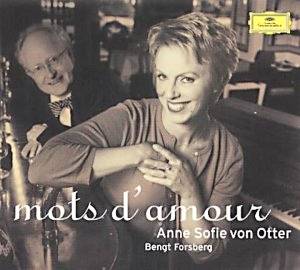************************************************************** EDITOR’s RECOMMENDATION January 2003 **************************************************************
Mots d'Amour
Music by Cécile Chaminade
Anne Sofie von Otter (mezzo-soprano) and Bengt Forsberg (piano)
With Nils-Erik Sparf and Peter Jablonski (piano II)
Available on Deutsche-Grammophon (DG) 471 331-2 Running Time: 76:09
Crotchet Amazon UK Amazon US

French composer Cecile Chaminade (1857-1944) was a protégé of Bizet, and student of Benjamin Godard; and her talent was recognised by Ambroise Thomas, Massenet, Gounod, Saint Saëns and Chabrier. She composed works for orchestra, a comic opera and a ballet but she is remembered for her sparkling songs full of charm and joie de vivre. They are redolent of the spirit of Paris, City of Lights, as celebrated in so many films. Given their appeal, it is extraordinary that they have been so overlooked by the recording companies.
This delightful compilation includes 25 of her songs, all little gems. I could wax enthusiastic about all of them in fact I ticked them all for comment as I listened through for the first time. Anne Sofie von Otter and Bengt Forsberg show great affection for them, their performances are very committed; a sense of fun and enjoyment is clearly communicated. Anne Sofie colours her voice according to their mood and sings most expressively enjoying every nuance and elegant lilt. Just to mention a few: 'L'amourcaptif' (Love Held Captive) is deliciously cheeky and capricious; 'Ma premiere lettre' (My First Letter) is an affecting remembrance of a first love letter; 'Nice-la-belle' (Nice the Beautiful) is an engaging high-spirited visit to sunny Nice full of flowers and gorgeous girls; 'Te souviens-tu?' (Do you remember?), to words by Benjamin Godard, is one of Chaminade's most beguiling melodies, and Ecrin (Jewel-case) teases naughtily both in the vocal and instrumental lines. The most substantial song is reserved until last the 5+ minute 'L'Été' (Summer) a beautifully evocative setting of words by Edouard Guinard that gives Von Otter the opportunity to show off her coloratura talents in a dazzling display of sheer joyeuse.
Additionally, there are six tracks of non-vocal music: three pieces for violin and piano (with Nils-Erik Sparf joining Forsberg) and another three numbers for two pianos with Peter Jablonski on second piano. Of the three pieces for violin and piano the opening Sérénade espagnole is performed in Fritz Kreisler's engaging arrangement. The following Rondeau is pleasant if a little formal while the Capriccio skits along down well-trodden salon music paths. Of the music for two pianos, Valse carnavalesque is a clever, jolly tour de force combining waltz figures with humorous material that suggests puppets on strings – there is an enchanting poignancy here too. Chaminade, herself, created something of a sensation when, in 1910, she played this piece accompanying herself playing second piano as a pre-recorded piano-roll pianola recording. Pas des cymbales is a sparkling piece recalling but without suggesting pastiche, Chabrier's Espana. Danse païnne is a little caprice looking back towards 19th century trifles.
A tonic for the winter months. Twenty-five delightful songs sung with great élan and affection by Anne Sofie von Otter splendidly supported by Bengt Forsberg and six sparkling bonus pieces for violin and piano, and two pianos.
Ian Lace
5
Return to Index